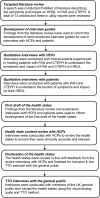A Health State Utility Study to Elicit Societal Values Associated with Pulmonary Hypertension
- PMID: 37650045
- PMCID: PMC10464901
- DOI: 10.2147/PPA.S400061
A Health State Utility Study to Elicit Societal Values Associated with Pulmonary Hypertension
Abstract
Aim: Pulmonary hypertension (PH) is a rare, severe, and progressive pulmonary vascular disease, which includes five subgroups with similar presentation. Symptoms include dyspnea, and fatigue, and can significantly impact one's health-related quality of life (HRQL). Although treatments are mainly medical, PH group 4, chronic thromboembolic pulmonary hypertension (CTEPH), can be managed with procedures, ie pulmonary endarterectomy (PEA) and balloon pulmonary angioplasty (BPA). Currently, drugs in Europe are only approved for pulmonary arterial hypertension (PAH), and CTEPH therefore the aim of this study was to elicit novel societal health state utilities in the UK for PAH and CTEPH based on disease severity, functional class (FC), clinical events, and treatment procedures specifically for CTEPH.
Material and methods: Six health states were defined: World Health Organization (WHO)-FC II, WHO-FC III, and WHO-FC IV [defined by the New York Heart Association (NYHA)]; PH-related hospitalization; and "BPA procedure and recovery" and "PEA surgery and recovery". Health states were based on a targeted literature review and two rounds of interviews with clinical experts (N = 4) and patients (N = 6). Draft health states were validated in cognitive debriefing interviews with clinical experts (N = 3). Health states were valued by the UK general public (n = 200), using a visual analogue scale (VAS) and time trade-off (TTO) assessment with the lead time method.
Results: The mean TTO values/utilities were 0.81 (FC II), 0.80 (BPA), 0.78 (PEA), 0.59 (FC III), 0.28 (FC IV), and 0.25 (PH-related hospitalization). Each progression in FC was associated with worse TTO scores.
Conclusion: This study reports societal utility values for PAH and CTEPH in the UK. It provides first utility estimates for states such as BPA procedure and recovery, PEA surgery and recovery and PH-related hospitalization for this population. The results show important distinctions between FC, treatment procedures, and hospitalization, and the significant burden of disease on HRQL.
Keywords: CTEPH; PAH; health-related quality of life; hospitalization; time trade-off; vignette.
© 2023 Nafees et al.
Conflict of interest statement
BN and HMdF were paid by Actelion Pharmaceuticals Ltd to conduct the research. AB is an employee of Actelion Pharmaceuticals Ltd, a Janssen Pharmaceutical Company of Johnson & Johnson. ET is an employee of Janssen Global Commercial Strategy Organization, High Wycombe, UK. WGS has received honoraria for speaking and consultation from Actelion Pharmaceuticals Ltd, a Janssen Pharmaceutical Company of Johnson and Johnson, Acceleron, Bayer, Gossamer Bio, and MSD. The authors report no other conflicts of interest in this work.
Figures
Similar articles
-
A Review of Clinical Trial Endpoints of Patients with Pulmonary Arterial Hypertension and Chronic Thromboembolic Pulmonary Hypertension and How They Relate to Patient Outcomes in the United States.J Manag Care Spec Pharm. 2017 Jan;23(1):92-104. doi: 10.18553/jmcp.2017.23.1.92. J Manag Care Spec Pharm. 2017. PMID: 28025931 Free PMC article. Review.
-
Efficacy and safety of balloon pulmonary angioplasty for residual pulmonary hypertension after pulmonary endarterectomy.Int J Cardiol. 2021 Jul 1;334:105-109. doi: 10.1016/j.ijcard.2021.04.013. Epub 2021 Apr 9. Int J Cardiol. 2021. PMID: 33839175
-
Pregnancy-associated plasma protein A - a new indicator of pulmonary vascular remodeling in chronic thromboembolic pulmonary hypertension?Respir Res. 2020 Aug 3;21(1):204. doi: 10.1186/s12931-020-01472-3. Respir Res. 2020. PMID: 32746916 Free PMC article.
-
Long-term clinical value and outcome of riociguat in chronic thromboembolic pulmonary hypertension.Int J Cardiol Heart Vasc. 2019 Feb 28;22:163-168. doi: 10.1016/j.ijcha.2019.02.004. eCollection 2019 Mar. Int J Cardiol Heart Vasc. 2019. PMID: 30859124 Free PMC article.
-
Recent progress in the diagnosis and management of chronic thromboembolic pulmonary hypertension.Respir Investig. 2013 Sep;51(3):134-46. doi: 10.1016/j.resinv.2013.02.005. Epub 2013 Apr 30. Respir Investig. 2013. PMID: 23978639 Review.
Cited by
-
Subjective Rationalities of Nonadherence to Treatment and Vaccination in Healthcare Decision-Making.Patient Prefer Adherence. 2024 Apr 11;18:821-826. doi: 10.2147/PPA.S454661. eCollection 2024. Patient Prefer Adherence. 2024. PMID: 38623311 Free PMC article.
-
Selection of patient-reported outcome measures in pulmonary arterial hypertension clinical trials: a systematic review, meta-analysis and health-related quality of life framework.Eur Respir Rev. 2025 May 14;34(176):250006. doi: 10.1183/16000617.0006-2025. Print 2025 Apr. Eur Respir Rev. 2025. PMID: 40368429 Free PMC article.
References
-
- Galie N, Humbert M, Vachiery L, et al; 2015 ESC/ERS Guidelines for the diagnosis and treatment of pulmonary hypertension. The joint task force for the diagnosis and treatment of pulmonary hypertension of the European Society of Cardiology (ESC) and the European Respiratory Society (ERS). Eur Heart J. 2015. doi:10.1093/eurheartj/ehv317 - DOI
LinkOut - more resources
Full Text Sources



